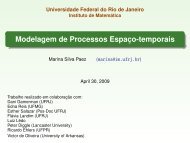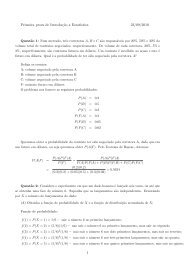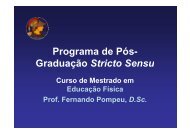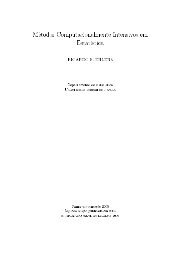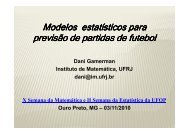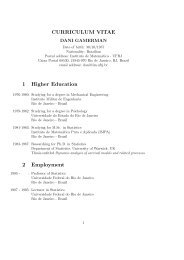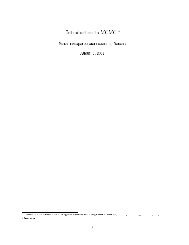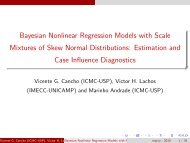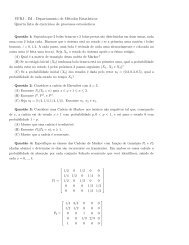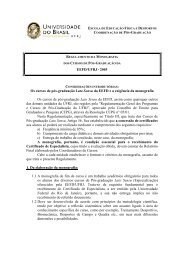<strong>and</strong> the non-exchangeable copula (ALM) associated to the asymmetric logistic model,seeTawn(1988)<strong>and</strong>Mendes(2005). UsingtheAICcriterionwefoundthebestcopula¯t as the Gumbel copula with ± =1:35, <strong>and</strong> tail dependence coe±cient ¸U =0:33.To assess the e®ects of volatility, the univariate data are previously ¯ltered usingthe Fractionally Integrated GARCH (FIGARCH) model. This °exible class ofmodels, able to capture the e®ects of long memory (or fractional integration) in theconditional variance, was introduced by Baillie et al. (1996), <strong>and</strong> Bollerslev <strong>and</strong>Mikkelsen (1999). To de¯ne a FIGARCH process, let fX t g t2Z be a stochastic processwith zero mean <strong>and</strong> X t = ¾ t Z t ,whereZ t is an independent identically distributedr<strong>and</strong>om variable with zero mean <strong>and</strong> unit variance, such that X t jF t¡1 are independentidentically distributed with mean 0 <strong>and</strong> variance ¾t 2 ,whereF t¡1 denotes the ¾-¯eldof the information set up to time t ¡ 1. Let º t = Xt 2 ¡ ¾t 2 . The conditional volatility¾ t of a FIGARCH(r; d; s) processisde¯nedford 2 [0; 1] throughwith¾ 2 t = ! (1 ¡ ¯(L)) ¡1 + ¸(L)X 2 t ;¸(L) =1¡ (1 ¡ ¯(L)) ¡1 Á(L)(1 ¡L) d <strong>and</strong> (1 ¡L) d =1+1X± d;k L k ;¡(k¡d)where ± d;k = ¡d , L is the lag operator, Á = ® + ¯, ®(L) =P r¡(k+1)¡(1¡d) i=1 ® iL i <strong>and</strong>¯(L) = P sj=1 ¯jL j .Notethatwhend = 0 it reduces to a GARCH model.To model the serial dependence in the mean <strong>and</strong> variance of the daily returns fromKorea <strong>and</strong> Singapore we ¯t combinations of ARMA(p; q) <strong>and</strong>FIGARCH(r; d; s) processes.We estimate by maximum likelihood the models derived by considering allcombinations p; q; r <strong>and</strong> s in f0; 1; 2g. We choose the best model using the AIC criterion.The best ¯t to Korea <strong>and</strong> Singapore turned out to be, respectively, ARMA(1; 0)-FIGARCH(1;d;1), <strong>and</strong> ARMA(1; 0)-FIGARCH(2;d;1) with all parameters estimateshighly signi¯cant, see Table 4. In this table, A st<strong>and</strong>s for the constant in the varianceequation, AR are the autoregressive terms in the model for the mean, ARCH(1) <strong>and</strong>ARCH(2) de¯ne the orders r, <strong>and</strong>GARCH(1)istheorders.Then, using the same proportions (0:18; 0:17) to de¯ne the thresholds on the ¯lteredseries free of volatility clusters, we obtained the FIGARCH st<strong>and</strong>ardized residualsexcesses. The MGPD distributions are ¯tted to the excess data, <strong>and</strong> the resultsare given in Table 3. Statistical tests applied to the empirical <strong>and</strong> estimated distributionsof ¯ltered excesses did not reject the hypothesis of identically distributed(p-value= 0:0723). Figure 1 illustrates, <strong>and</strong> shows the scatter plot of bivariate data,using the (raw) daily excess data (at left), <strong>and</strong> the ¯ltered excesses (at right). Theformal tests carried on <strong>and</strong> Figure 1 suggest that non-exchangeability may be a resultof short <strong>and</strong> long memory in volatility. However, even though these excess residualsare identically distributed, they failed to be exchangeable: We found the best ¯t to bethe one provided by the ALM asymmetric copula, with parameters estimates equalto (1:19; 0:96; 0:82), yielding ¸U =0:19, see Table 2.34k=1
Table 3: ARMA + FIGARCH ¯ts to daily returnsfrom Korea <strong>and</strong> Singapore indexes.Korea : ARMA(1; 0)+FIGARCH(1;d;1) Singapore: ARMA(1; 0)+FIGARCH(2;d;1)Value Std.Error t value Pr(> jtj) Value Std.Error t value Pr(> jtj)AR(1) 0.11763 0.02084 5.646 9.110e-009 0.1151 0.019923 5.775 4.298e-009A 0.06975 0.02772 2.517 5.954e-003 0.0295 0.008441 3.495 2.410e-004GARCH(1) 0.53477 0.06354 8.416 0.000e+000 0.7562 0.046910 16.121 0.000e+000ARCH(1) 0.22228 0.04286 5.186 1.154e-007 0.3750 0.057193 6.557 3.303e-011ARCH(2) 0.1561 0.029486 5.295 6.453e-008fraction 0.39866 0.05110 7.802 4.441e-015 0.4855 0.043910 11.057 0.000e+000Nelsen (2005a) studies non-exchangeability <strong>and</strong> proposes a non-exchangeabilitymeasure for the case of identically distributed margins. The degree of exchangeabilitymay be measured by computing the maximum of the absolute value of the di®erencesH(x; y) ¡ H(y; x). For identically distributed margins with joint distribution H <strong>and</strong>copula C, the set of values of jH(x; y) ¡ H(y; x)j are the same of jC(u; v) ¡ C(v; u)j.Thus he proposes to compute 3maxjC(u; v) ¡ C(v; u)j, for all u; v 2 [0; 1] 2 .Herewesuggest to use an empirical version of this statistics, using the observed pairs <strong>and</strong>the ¯tted ALM copula. Note that, by the Glivenko-Cantelli theorem, as the samplesize goes to in¯nity, the sample version should approach the true value. The valueobtained using the empirical version of Nelsen's measure of non-exchangeability was0:0058.Summarizing, we provided an example where non-exchangeability was found foridentically distributed r<strong>and</strong>om variables, <strong>and</strong> long memory in volatility was responsiblefor changes in dependence structure, increasing extremal dependence. Workscombining copulas <strong>and</strong> short memory processes (GARCH type) modelling includeGoorbergh et al. (2005) <strong>and</strong> Breiman et al. (2003) among others.5 ConclusionsThe independence assumptions, which are typical in many statistical models are oftendue more to convenience rather than to the problem in h<strong>and</strong>. Furthermore, there aresituations where neglecting dependence e®ects may occur into a dramatic underestimationfor quantity of interest (some appropriate risk measure, for example). Takingcare of dependencies becomes therefore important in order to extend st<strong>and</strong>ard modelstowards more e±cient ones. However, relaxing the independence assumption yieldsmuch less tractable models. The pitfall of the copula approach is that it is usuallydi±cult to choose or ¯nd the appropriate copula for the problem in h<strong>and</strong>. An alternativeis suggested in Section 3.3. Often, the only possibility is to start with someguess such a parametric family of copulas <strong>and</strong> then to try to ¯t the parameters. Asa consequence, the model obtained may su®er a certain degree of arbitrariness.35
- Page 3 and 4: can be employed in probability theo
- Page 5 and 6: y Genest et al. (1993) and Shi and
- Page 7 and 8: Table 1: Distribution of (C 1 jC 2
- Page 9 and 10: It should be mentioned here that gr
- Page 11 and 12: Nelsen et al. (2003) have used Bert
- Page 13 and 14: 2.4 Time dependent copulasIn practi
- Page 15 and 16: De¯nition (conditional pseudo-copu
- Page 17 and 18: (i) Ã 1 (x 1 ;::: ;x n )=x 1 + :::
- Page 19 and 20: (1999)) even in the cases where the
- Page 21 and 22: Let R u = P nj=1 IfU j · ug and R
- Page 23: usually wish to aggregate two-dimen
- Page 26 and 27: 3.3 Copula representation via a loc
- Page 28 and 29: such thatC(u; v) =© ru;v¡© ¡1 (
- Page 30 and 31: Fisher-Tippett Theorem (version for
- Page 32 and 33: et al. (2000). To measure contagion
- Page 36 and 37: 0 2 4 6 8 10 120 1 2 3 4 5 60 2 4 6
- Page 38 and 39: Bouye, E., Durrleman, V. Nikeghbali
- Page 40 and 41: Embrechts, P., Lindskog, F., McNeil
- Page 42 and 43: Hsing, T, KlÄuppelberg, C., Kuhn,
- Page 44 and 45: Nelsen, R., Quesada-Molina, J., Rod



